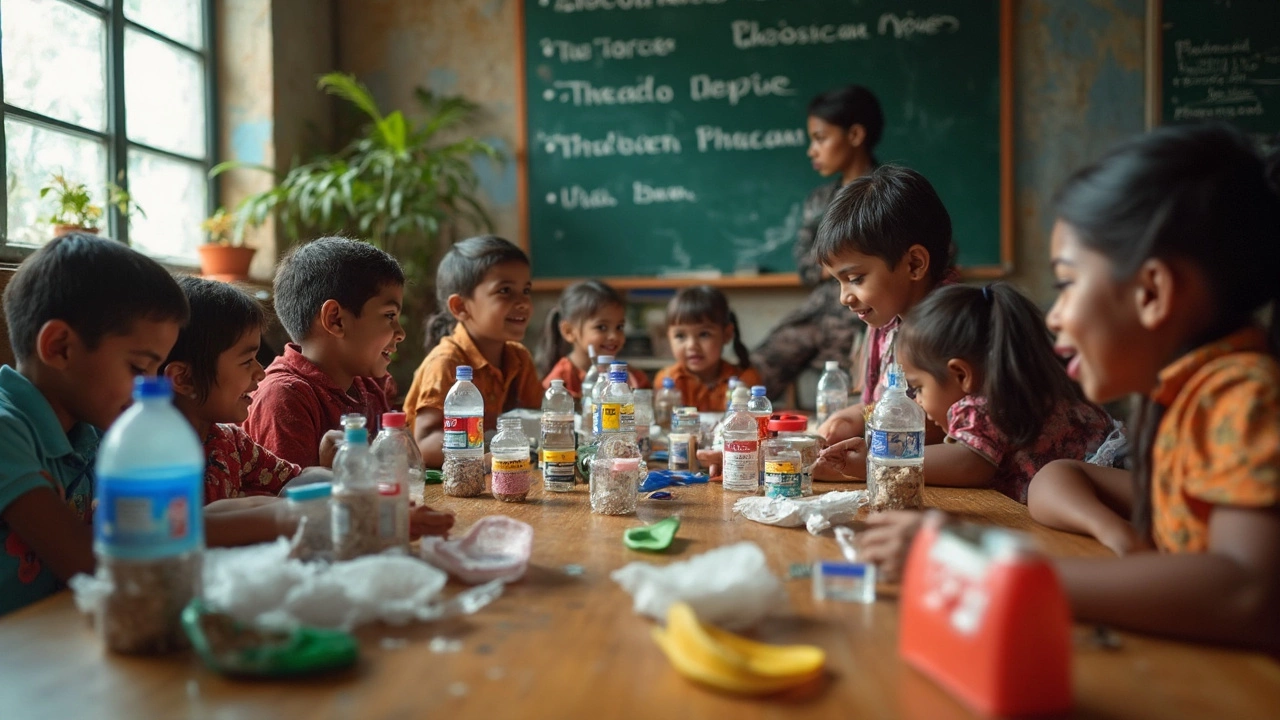Plastic Manufacturing Giants: Who Makes Most of the World's Plastic?

Ever look around and notice just how much plastic is everywhere? It’s in packaging, bottles, cars, electronics—you name it. But have you ever stopped to think about who’s actually making all this stuff? Turns out, just a handful of companies crank out most of the world’s plastic, and some of them are brands you probably deal with every single day.
Knowing which companies are behind the flood of plastic isn’t just trivia—it helps you see how global industries shape what ends up in your trash bin. A bunch of these companies don’t just make plastic, they also supply the raw stuff to brands that use plastic in nearly everything: soda bottles, shampoo containers, snack wrappers, takeout boxes. Once you know the big players, you start seeing their fingerprints everywhere.
- Who Makes the Most Plastic?
- Top 10 Plastic-Producing Companies in 2025
- Why These Companies Dominate
- How Their Plastic Ends Up Everywhere
- Surprising Facts About Their Products
- What You Can Do as a Consumer
Who Makes the Most Plastic?
If you’ve got plastic in your hand right now, odds are it can be traced back to a small group of giants in the industry. It’s not hundreds of companies pumping out all the plastic you see—it’s really just a few huge players dominating the scene worldwide.
The biggest producers are often oil and gas companies or chemical corporations that crank out the raw plastic—called resin or polymer pellets—that other businesses turn into bags, bottles, lids, and more. These names don’t pop up on your packaging, but they’re behind most of what you use. When we talk about plastic manufacturing, think of these as the 'factories behind the factories'.
Check out the leaders in terms of pure volume. This table spotlights the top companies by estimated plastic output (measured in millions of metric tons per year) as reported by industry analysts and the 2023 Plastic Waste Makers Index:
| Company | Country | Annual Plastic Output (Million Metric Tons) |
|---|---|---|
| ExxonMobil | USA | 9.0 |
| Dow | USA | 7.8 |
| Sinopec | China | 5.9 |
| INEOS | UK/Switzerland | 5.2 |
| Saudi Aramco | Saudi Arabia | 4.5 |
| LyondellBasell | Netherlands/USA | 4.0 |
| Reliance Industries | India | 3.4 |
To put those numbers into perspective, ExxonMobil alone makes enough plastic each year to wrap the whole planet in cling film—several times over. These companies aren't just making a lot of plastic; they’re setting the pace for everyone else.
It’s interesting to note most of these names aren’t regular household brands. But their products end up in the packaging from your favorite soft drink, snack, or e-commerce delivery. Next time you toss out a plastic wrapper, there’s a decent chance it started out as resin from one of these players.
A helpful tip: if you ever spot the recycling triangle with numbers 2, 4, or 5, it’s a safe bet that plastic was originally produced by one of these global giants.
Top 10 Plastic-Producing Companies in 2025
A lot of people are surprised to find out that just ten companies are behind a huge chunk of the world’s plastic production. These are mostly big petrochemical and energy giants, and together they’re dominating the global plastic scene. In fact, research from 2024 shows these companies are responsible for over half of single-use plastic waste found all over the world.
Here’s a quick rundown of who’s leading the pack:
- ExxonMobil
- Dow Inc.
- Sinopec
- Indorama Ventures
- Saudi Aramco
- LyondellBasell
- Reliance Industries
- PetroChina
- Braskem
- Alpek
These companies control massive factories that churn out plastic used by thousands of brands. Most operate across continents, with production sites in the Americas, Asia, Europe, and the Middle East. They mostly deal with types like polyethylene, polypropylene, and PET—stuff you’ll spot in packaging, bottles, or food containers every day.
You might wonder how much plastic these companies actually make. The numbers are kinda wild. Here’s a table showing estimated single-use plastic resin output (in million tonnes) for each in 2024:
| Company | Single-Use Plastic Output (M tonnes) |
|---|---|
| ExxonMobil | 5.9 |
| Dow Inc. | 5.7 |
| Sinopec | 5.6 |
| Indorama Ventures | 4.6 |
| Saudi Aramco | 4.3 |
| LyondellBasell | 3.9 |
| Reliance Industries | 3.1 |
| PetroChina | 3.1 |
| Braskem | 2.8 |
| Alpek | 1.5 |
Just looking at these numbers, it’s clear that a few industry leaders stand out. Plastic manufacturing isn’t just their side business—it’s their core game. Some of these companies have even pledged to invest in recycling technology or reduce their plastic output, but so far, the stats show production keeps climbing.
Next time you see a typical soda bottle or snack wrapper, there’s a good chance the raw plastic was produced by one of these companies. You probably touch stuff from these giants every single day, whether you know it or not.
Why These Companies Dominate
Ever wondered how a few names manage to control most of the plastic flow? It mostly comes down to scale, access to cheap fossil fuels, and serious global reach. Companies like ExxonMobil, Dow, and Sinopec have built giant networks of factories and pipelines that pump out plastic by the millions of tons every year. And because they’re also huge petrochemical giants, they get direct access to the necessary oil and gas without middlemen.
Once you get this big, you get special perks—better deals on raw materials, top-notch technology, and years of experience making plastics cheap and reliable. Take Dow and ExxonMobil, for example; they’ve both been pouring money into research to make plastics that work for just about everything, from food packaging to industrial construction. And if you look around, most countries don’t have companies that can match this kind of supply chain muscle.
Here’s the kind of influence these top producers have globally:
| Company | Estimated Annual Plastic Production (million tons, 2024) | Main Markets |
|---|---|---|
| ExxonMobil | 13.3 | Global (US, Asia, Europe) |
| Dow | 12.2 | Global (US, Asia, Latin America) |
| Sinopec | 11.6 | China, Asia, Global |
| LyondellBasell | 9.5 | US, Europe, Asia |
| Saudi Aramco | 8.8 | Middle East, Asia, Europe |
All this muscle means these companies can keep prices low while dumping out insane quantities of plastic. The cherry on top? They’ve signed massive contracts with brands in food, beverage, and retail, locking in the demand for their products. That’s why you see their plastic in everything from your water bottle to the plastic wrap on fruit.
One of the top reasons these plastic manufacturing titans stay ahead is how fast they adapt. When a packaging trend changes, like the big push for flexible food wraps, these guys already have a new version ready to hit the market. Their size also lets them absorb new regulations or environmental taxes way better than smaller players—it just dents their huge profits instead of knocking them out.
It’s basically a feedback loop: their dominance brings more cash, more research, and even cheaper production, which keeps them on top while everyone else struggles to catch up.

How Their Plastic Ends Up Everywhere
It’s wild how plastic made by a few big companies ends up just about everywhere, from grocery shelves to remote beaches. The process is pretty straightforward but surprisingly hard to stop. Most of the major players, like ExxonMobil, Dow, Sinopec, and Indorama Ventures, pump out billions of kilograms of plastic resin every year. That resin gets sold to thousands of brands that turn it into packaging, bottles, clothing fibers, car parts—you name it.
After manufacturing, these plastic products travel across continents. Some are used for just a few days (think takeout containers or water bottles) before getting tossed. Here’s where things get messy. Lots of countries don’t have the infrastructure to process or recycle all this plastic. So, waste piles up in landfills, gets shipped overseas, or escapes into nature. A study from 2023 showed that around 11 million tons of plastic enters the world’s oceans every year, and much of this can be traced back to just the top 20 plastic-producing companies.
- Food and drink packaging—wrappers, bottles, and trays are the biggest chunk of single-use plastics, often produced by companies like Dow and LyondellBasell.
- Textile fibers—for example, Indorama Ventures is the biggest producer of polyester fibers (used in everything from t-shirts to carpets).
- Everyday products—like shopping bags, toothbrushes, electronics casings, all start with resin bought from these plastic manufacturing giants.
Here’s an idea of just how concentrated plastic production is among the top companies:
| Company | Estimated Plastic Resin Output (2024, million tons) | Main Products |
|---|---|---|
| ExxonMobil | 8.1 | Polyethylene, polypropylene |
| Dow Inc. | 6.9 | Polyethylene, packaging plastics |
| Sinopec | 5.6 | Polyesters, raw plastic materials |
| Indorama Ventures | 6.4 | Polyester, PET |
The crazy thing? The bulk of all plastic ever made still exists somewhere—either buried, burned, or floating around, because it takes hundreds of years to break down. So when you spot a plastic cup on a beach, there’s a solid chance it can be traced back to one of these plastic giants. The chain from factory to landfill is short, but the impact stretches way beyond.
Surprising Facts About Their Products
Here's something wild—some of the biggest plastic manufacturing companies also make the stuff that goes into everything from grocery bags to car parts and even kids' toys. ExxonMobil, for example, makes so much plastic resin each year that if you stacked the bottles made from it end-to-end, they'd circle the earth dozens of times. Their polyethylene and polypropylene are pretty much everywhere.
Most people don’t realize that one out of every five plastic bottles in the world comes from just a couple of these mega-producers. In fact, according to a report from 2023, just 20 companies were responsible for about 55% of the world’s single-use plastic waste.
- Dow, one of these giants, supplies materials for cling wrap, shampoo bottles, and even pipes used in plumbing.
- Sinopec in China produces so much plastic that the company fuels not just national demand, but also exports plastics worldwide.
- INEOS, a lesser-known name, quietly churns out plastic used in disposable coffee cups and medical devices—stuff you probably touch daily.
What’s even crazier is that plastic manufacturing companies blend different chemicals to get specific properties. For example, the clear, flexible plastic for food wraps uses additives to make it more stretchy, while the thick stuff in detergent jugs gets toughening agents. You probably eat from or drink out of something made with modified plastics every week.
| Company | Main Products | Annual Plastic Output (Million Tons) |
|---|---|---|
| ExxonMobil | Polyethylene, Polypropylene | 11.3 |
| Dow | Polyethylene, Polyurethane | 9.7 |
| Sinopec | Polyethylene, Polypropylene | 8.3 |
| INEOS | Polystyrene, Polypropylene | 6.9 |
Next time you grab a snack or groceries, take a look at the packaging. Odds are, the plastic came from one of these companies. Some even make plastics for the medical field, so the same producer behind your water bottle could also be making intravenous (IV) bags at the hospital.
Here’s another kicker: a chunk of ocean plastic can usually be traced to products from these few heavy hitters. The next time you recycle or toss out packaging, remember you're just one tiny link in a chain that starts with some of the world’s largest companies.
What You Can Do as a Consumer
It might feel impossible to dodge plastic in daily life, but regular people have more power than they think. Every small move adds up, especially when you realize that the biggest plastic manufacturing companies pay attention to what shoppers want. Here are some realistic, off-the-shelf steps you can take to make a difference—and it’s not all about ditching straws or carrying a tote bag.
- Check product labels and packaging: Look for plastic codes and info about post-consumer recycled content. Brands are starting to shout about using less or recycled plastic. The more you pick these, the more they notice.
- Cut single-use plastics where you can: Buy a reusable water bottle, skip plastic cutlery, and choose loose produce instead of pre-wrapped stuff. This sounds basic, but it eats into the business model of brands pushing single-use packaging.
- Support refill and bulk stores: More shops now let you bring your own containers. Each time you refill detergent or rice, it’s one less plastic tub in a landfill—plus, you’re voting for businesses trying to curb plastic waste.
- Call out companies: If you spot excessive plastic packaging, tag the company online. Big brands have responded to social media backlash by changing their ways faster than with government rules.
- Know your plastic: Not all plastic is recycled equally. #1 PET and #2 HDPE are more likely to get recycled, but #3 and #6 usually head straight for the dump. Learn these symbols and try to avoid the problem plastics when shopping.
- Talk to your local stores: It works. Lots of supermarkets now stock more eco-friendly brands or drop plastic bags because shoppers kept asking. If enough people push, even giants like Coca-Cola and Nestlé take a fresh look at their packaging deals.
One last thing—if you feel overwhelmed, focus on swaps that are easy for you. Share tips with friends, get your family on board, or challenge your office to go plastic-light for a week. The less you support the old-school way of doing things, the quicker these giant companies will rethink their plastic obsession.





